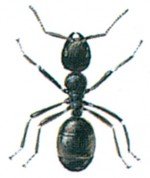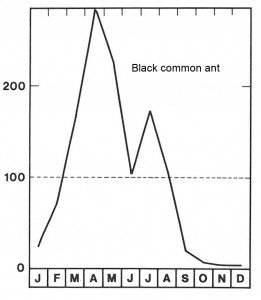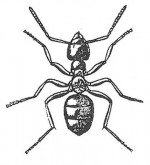Latin: Lasius niger.


This is the species most frequently encountered indoors. An ant colony usually consists of a dozen thousand ants, and the colony is placed in the ground. In buildings, the ants establish colonies in cavity walls and under floors. Outside, they have a certain fondness for building colonies under tiles. They penetrate anywhere through cracks to seek food. The common black ants live mainly of sweet liquids. In nature they live of aphid excrement, but also various small insects, which they overpower. In private households, shops and businesses the ants especially seek towards sweet and sugary foods. The common black ants hardly have any significance as disease carriers. Often the first signs of ant activity inside, are small piles of sand and gravel, which suddenly appear by panels. These are the ants’ waste piles and one can in the dredged material find insect remains, empty pupae and dead ants.
The most effective extermination will of course be to find and destroy the colonies. Unfortunately, this is often impossible when the ants live inside a building. In those cases you have to experiment with the next best option: to eradicate the adult ants gradually as they show themselves. For this you can use insect powder. Baits with honey and borax can also be effective, but due to the risk of poisoning bees these may only be used indoors. Take one part water to four parts honey and mix well. To 0.5 dl of this mixture, add a teaspoon of borax. It is important that the borax is properly dissolved. You can warm the mixture by shaking it under a hot tap to help that process on its way.

The bait must be set up somewhere that it does not bother having ants crawling around. The ants fill their stomachs with the poisoned honey and distribute it to other ants and offspring in the colony. Provide the ants plentiful before they suspect something. Do not tempt children or pets with this bait by placing or forgetting it in somewhere that they can get to it. Ants on the premises are particularly a spring phenomenon. In summer, they prefer to seek their food outside. However, they still live in or under the building.
The winged ants, which are found in the middle of summer, are males and females which in hot and sultry weather take off on a mating flight. When winged ants occur indoors, it is fortunately only for a short time. You cannot prevent them from flying in, but you can spray with an aerosol containing pyrethrin and then gradually vacuum or sweep the dead ants away.




